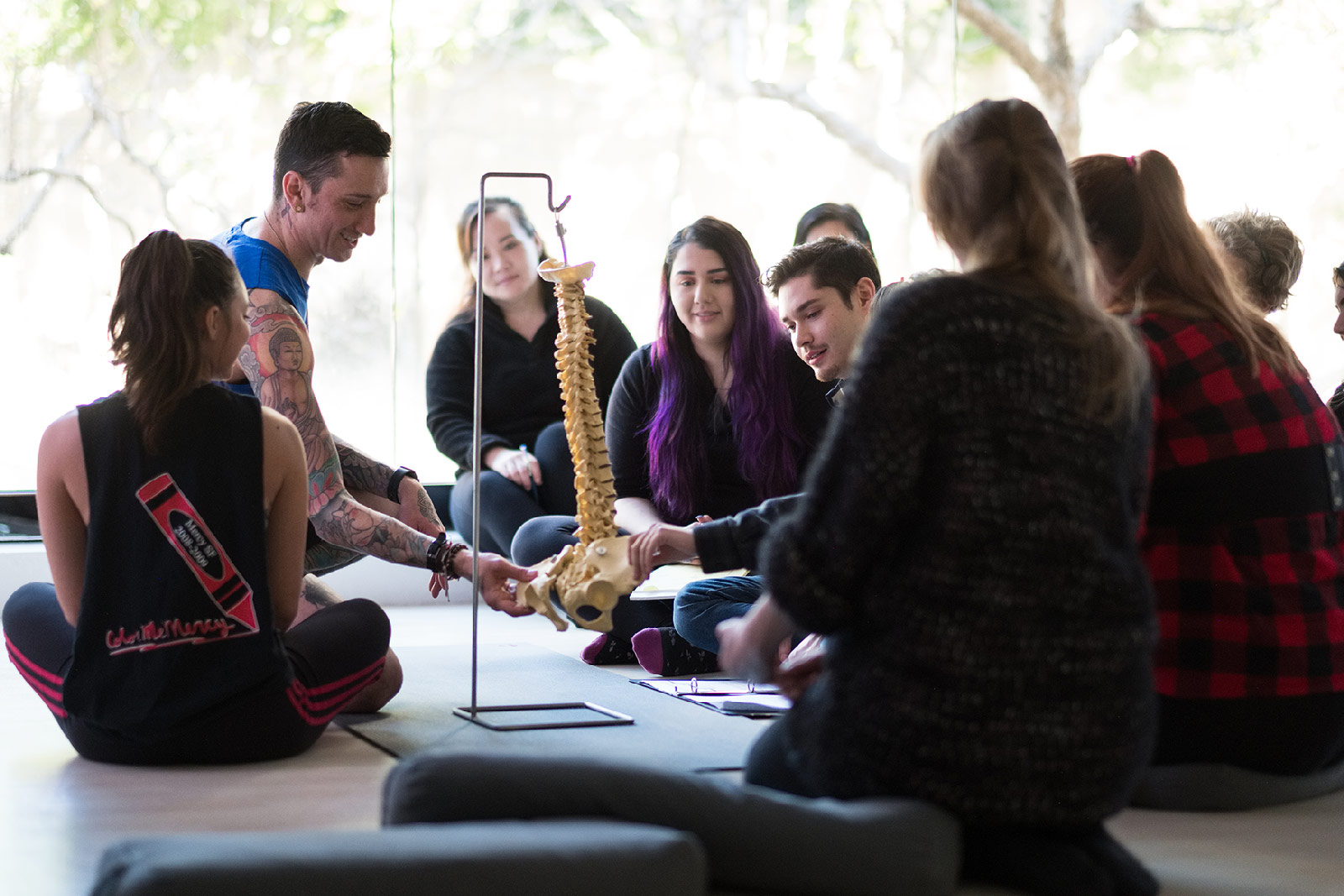
Congratulations! You’ve decided to do your yoga teacher training. This is such an exciting and life-changing experience that you’re about to embark on.
Why?
There are countless benefits of taking YTT. You’ll not only learn about how to teach yoga and all the fancy yoga postures, but you’ll also deepen your own personal practice.
Both physically and spiritually.
It’ll take you beyond anywhere any of even your favorite yoga classes could have taken you and give you so much more than the title of ‘yoga instructor’.
The problem?
This is only true if you choose the right training program.
Unfortunately, not all yoga instructor courses are created equal (but all will gladly take your money).
So knowing how to choose a teacher training program is super important. And I’ll help you do exactly that 🙂
How to Choose a Yoga Teacher Training Program
A yoga teacher training course will teach you so much more than the physical postures. You’ll also study yoga philosophy, mindfulness, pranayama and anatomy. You’ll dive into the Yoga Sutras and learn that an authentic yoga practice actually has very little to do with asana (aka yoga postures). You’ll learn the difference between vinyasa yoga, Ashtanga yoga, hatha yoga, yin yoga, yoga nidra, tantra yoga… all the yogas!
This in-depth study of yoga will transform your physical practice and possibly your life.
So how do you finally settle on a training program that you can be certain isn’t a major scam?
Well, there are literally thousands of programs to choose from. You could choose a 200-hour program or a 300-hour advanced yoga teacher training course. You could train anywhere from your neighborhood studio to the mountains of Nepal. Even the comfort of your own living room is now an option with an online teacher training program.
While there is no magic formula for choosing the right yoga teacher training, there are some things to consider that will help guide you in the right direction.
Let me break some things down that helped me and might also give you some clarity.
You might also like: How to Be a Yoga Instructor: 6 Things You MUST Know Before You Begin
1. Set Your Intention
To be honest, I would recommend doing this before any new venture, but it’s especially important here.
Get clear about why you are doing this and what you hope to get out of it. This will not only narrow down your choices, but it will also help you actually reach your goals.
One major question to consider is whether or not you even want to teach yoga? Is a Yoga Alliance yoga instructor certification important to you (aka RYT status)? Do you want to study a particular yoga style?
If there is a particular lineage or style that you want to learn, then find a training that specializes in the area you’re interested in. Most programs will teach a variety of yoga styles, but you can find specially focused ones as well.
If you’re not even interested in teaching yoga, then look for a yoga school that focuses more on the topics that you’re genuinely interested in.
If you’re serious about teaching yoga, then look for a yoga school that follows a teaching methodology that you can see yourself using (or a teacher trainer that you really admire).
If your working towards growing your own yoga business, then choosing a 300 hour yoga training program might be a good option for you.
Knowing the answers to all of these questions will help you find a yoga instructor training that is absolutely perfect for you (and avoid the many, many scammy teacher training centers out there).
You might also like: 10 Signs You’re Ready For A Yoga Teacher Training This Year
2. Decide How You Want To Apply Your Knowledge
This is a good follow up question to ask after setting your intention. There are so many different career paths that a yogi can take and being a yoga teacher is only one of them.
If teaching at a specific yoga studio is what calls to you, I highly recommend doing your training there. Some studios have a unique teaching style and require their teachers to do the in-house training.
This makes your decision quite easy.
Teaching in a yoga studio will most likely require you to have your Yoga Alliance certification. In order to be a registered yoga teacher (RYT), you have to do your training through a YA registered yoga school. Make sure that your program is certified if that’s what you’re looking for.
But to be honest, the Yoga Alliance doesn’t do much other than take your money and give you a fancy instructor certification. It doesn’t ensure that your chosen training program is good quality or that you are ready to teach yoga upon completion.
You might also like: What is Yoga Alliance and Do I Need an RYT Certificate to Teach Yoga?
If you’re interested in making money as a yoga instructor, there are lots of ways to do it without having to get a YA yoga instructor certification. (Like, for example, leading a yoga retreat!)
And, of course, you don’t ever have to teach yoga either.
Maybe you just want to dive deeper into the Yoga Sutras, learn how to incorporate pranayama, meditation, and the many styles of yoga into your own daily life. Maybe you just want to learn about anatomy and physiology to improve your own asana practice.
Maybe you just want to get to know other people who are passionate about yoga.
Whatever the case may be, figure out how you will apply your knowledge and then find a program that will help you do exactly that.
Take my quiz to find out which YTT is best for you:
3. Think About Which Style Of Yoga You Want To Study
Hatha yoga is nearly always included in a YTT. It is the foundational style of yoga that was originally handed down through the ancient texts.
All other styles of yoga were born out of this.
A lot of training programs now will teach a variety of styles of yoga, such as Ashtanga, vinyasa flow or yin yoga.
There are some trainings that focus specifically on a certain style, which is common for Ashtanga and Iyengar styles of yoga. If that’s what you want to get a deeper understanding of, then look out for an immersion program that focuses on that.
If you are completely undecided, that’s no problem either!
Studying these different styles in depth will give you a good idea of what resonates with you.
You might also like: Levels of Yoga Certification: What The Heck Is The Difference Between 200-, 300-, and 500-Hour YTT Courses?
4. Consider Your Learning Style
During your teaching training, you will be taking in A LOT of information! It’s fascinating, enlightening, life-changing…
…and can be a bit overwhelming at times.
So you need to figure out the best way for you to handle that.

If you would rather dive in and fully immerse yourself in the process, then an intensive immersion program is a good choice. In an immersion program like this, you can unplug and focus solely on getting a deeper understanding of yoga.
Taking away distractions from daily life can be really helpful and even necessary for some people.
On the other hand, extended programs allow you to take your time and really absorb everything by allowing you to get your training hours on the weekends.. This gives you the time to put certain things into practice as you learn them.

Many people are turning to online YTT programs, where students can study from home but still get super individualized guidance for their yoga journey.
We don’t all learn the same way. It’s important to honor your own unique learning style and choose the program that will best suit you.
Get to know me a bit more in this FAQ session all about Uplifted Yoga:
5. Think Of Location
Some of us are deeply involved in our local communities. Others long for a great adventure in faraway places. Others still are rooted in their current lives but long for a community, they can reach easily through their computers.
Think about which team you belong to and factor that into your decision.
If you regularly go to a studio where you live, you might consider doing it there. Yoga teacher trainings are an important source of income for studios. By doing your training with them, you would be supporting your own community.
Then there are the adventure seekers. By choosing to do your training abroad you can give yourself a whole immersive experience. Many students seek teacher training courses in India so that they can study with lead teachers who have grown up practicing yoga since birth. Others opt for luxury style training courses, tucked away on the tropical beaches of Bali or Thailand.
After all, if you’re going to take four weeks off of work just for your teacher certification, might as well make it happen in a beautiful location!
What is becoming an especially popular trend is doing an online YTT program (like mine), which allows you to dive deep into your yogic understanding without totally disrupting your daily life.
As with all programs, be super vigilant about what they offer, what their existing student network is like, and what their reputation is. Just because it’s convenient, affordable, or in the Motherland of Yoga (India), doesn’t mean that it will be high quality.
You might also like: How To Know If An Online YTT Is Legit: 8 Things To look For
Fall in love with my 200-Hour teacher training or …
Experience 3 Training Videos from Inside My 200-Hour Online YTT

6. Consider Time Constraints
We don’t all have flexible jobs or loads of free time. Some people work full-time and have families to take care of. Luckily, this doesn’t mean that a teacher training is out of the question.
There are two general formats for a yoga teacher training. Both of them will teach all the same things, but the 200 hours are allocated differently.
An extended program is one that runs on nights and weekends. The length of this type of program is usually around 6 months. But, sometimes they can even run as long as a year. If your time is limited or you like to take your time and apply the knowledge as you learn it, this format may be best for you.
If you have a flexible job or are able to get extended time off, you may consider an intensive program. An intensive program is one that is done full-time, 5-6 days a week. These are usually about a month in length.
Need even more flexibility? You now have the option of doing your teacher training online. The course can be done on your schedule and at your own pace.
There is no right or wrong here. Choosing an intensive program doesn’t mean you are learning more. No matter what format you choose, you will be learning the standard curriculum of asanas, anatomy, pranayama techniques, meditation and yoga philosophy.
7. Think Of The Cost (But Only A Little)
I’m sure most of us would love to never have to think about money. It definitely should not be a major deciding factor, but is one you’ll probably need to consider. The fact is, yoga teacher training costs money! How much, exactly, will vary according to a few features of the program.
If you are doing your YTT abroad, then there are other costs you’ll have to factor in. Along with the cost of the program, you’ll have to think about the flight to the destination. Also, the cost of accommodation and food (if it’s not already included).
Some may even offer a payment program or a work trade opportunity. There are so many different ways to make it happen, even if you have a limited budget.
At the end of the day, you want to go where you are most comfortable. If this happens to be the most expensive program, then so be it. Maybe you’ll just have to save a little longer to make it happen.
8. Talk To Other Teachers About Their Experiences
Sharing experiences can be one of the best ways to find out about the yoga community as a whole. If there’s a certain person whose teaching style you really admire, talk to them and find out who their teacher was. Or, maybe they even run their own certification program. Many experienced teachers also lead yoga teacher trainings.
If you have a particular program picked out, talk to some former students. Hearing their experience can give you some insight and help you decide if it’s right for you.
Ultimately, the decision is yours. What was great for one person might not be right for you.
You might also like: 10 Truths About Becoming a Yoga Instructor (That Nobody Talks About)
9. Go Where You Feel At Home
If there is a particular yoga studio or teacher that resonates with you, train with them. A yoga teacher training will be physically and mentally challenging. Being in a comfortable and supportive environment is the best way to set yourself up for a most wonderful adventure.
And if there isn’t a particular yoga instructor or studio that you know and love yet, then get to know a few. Attend their classes or watch their videos online. The more experience you have as a student, the more clear you can get about what kind of yoga teacher (or yoga education) experience you’d like to be.
After all, this is the person that you will be learning how to teach yoga from. So your style, your approach, your understanding will come from this person. So make sure that you actually like your teacher trainer and the way they do things.
Next Steps
- Check out my YouTube channel and find some yoga classes that you can try out for yourself!
- Explore my knowledge hub for How to Become a Yoga Teacher
- Attend a 200 YTT info session to see what else you’ll learn in my online teacher training.
Experience 3 Training Videos from Inside My 200-Hour Online YTT

YOU MIGHT ALSO LIKE
- What is Yoga Alliance and Do I Need an RYT Certificate to Teach Yoga?
- 200 Hour Yoga Teacher Training: What To Expect, How To Prepare, Where To Do It
- Is An Online Yoga Teacher Training Worth The Investment?
- Levels of Yoga Certification: What’s The Difference Between 200-, 300-, and 500-Hour YTT Courses?yoga certification
- What Does A 500 HR Yoga Teacher Training Course Cover? Standards and Benefits
- A Guide to The Best Yin Yoga Teacher Training Programs
- Hatha Yoga Teacher Training Certification: Immersion, Online, or in Studio?
- Wanna Teach Kids Yoga? Find A Fun Childrens Yoga Teacher Training!
- Ashtanga Yoga Teacher Certification: Where And How To Get It
- How To Know If An Online YTT Is Legit: 8 Things To Look For
- Want to Become a Certified Vinyasa Yoga Teacher? Read This.
- How to Choose a Yoga Teacher Training (That Won’t Rip You Off)










